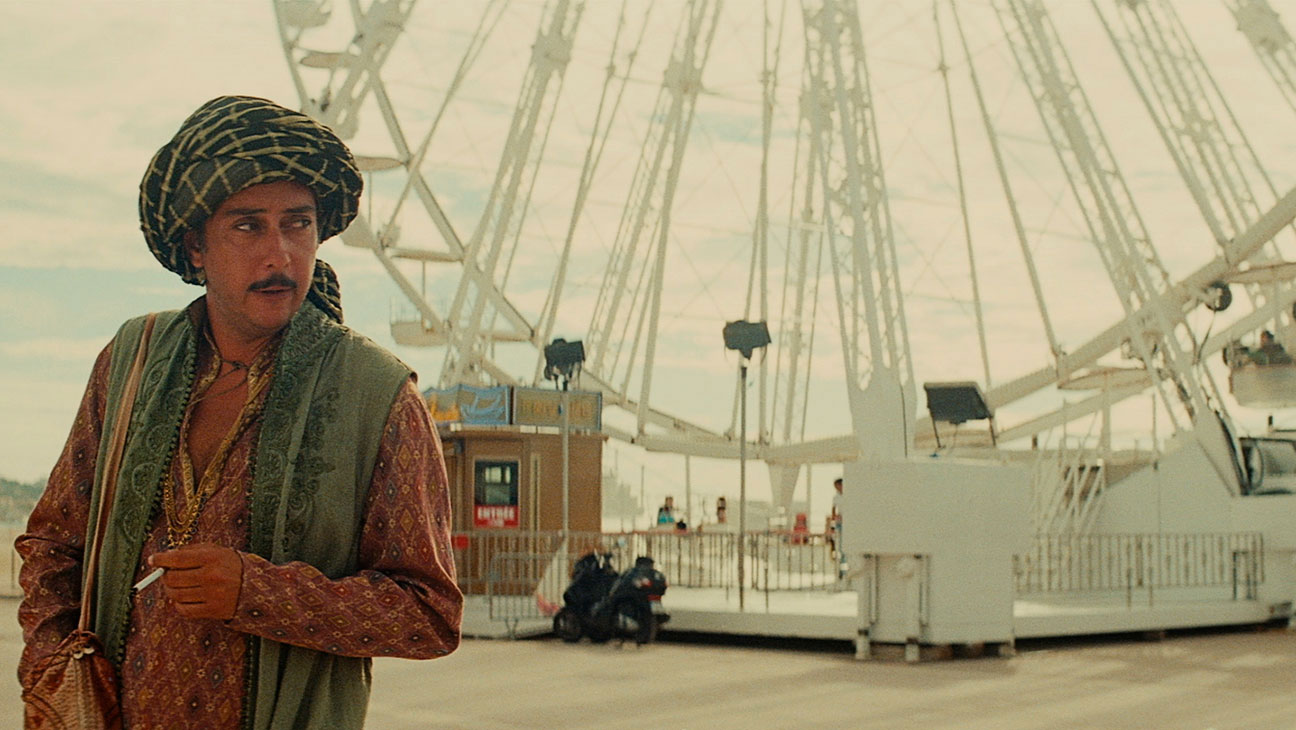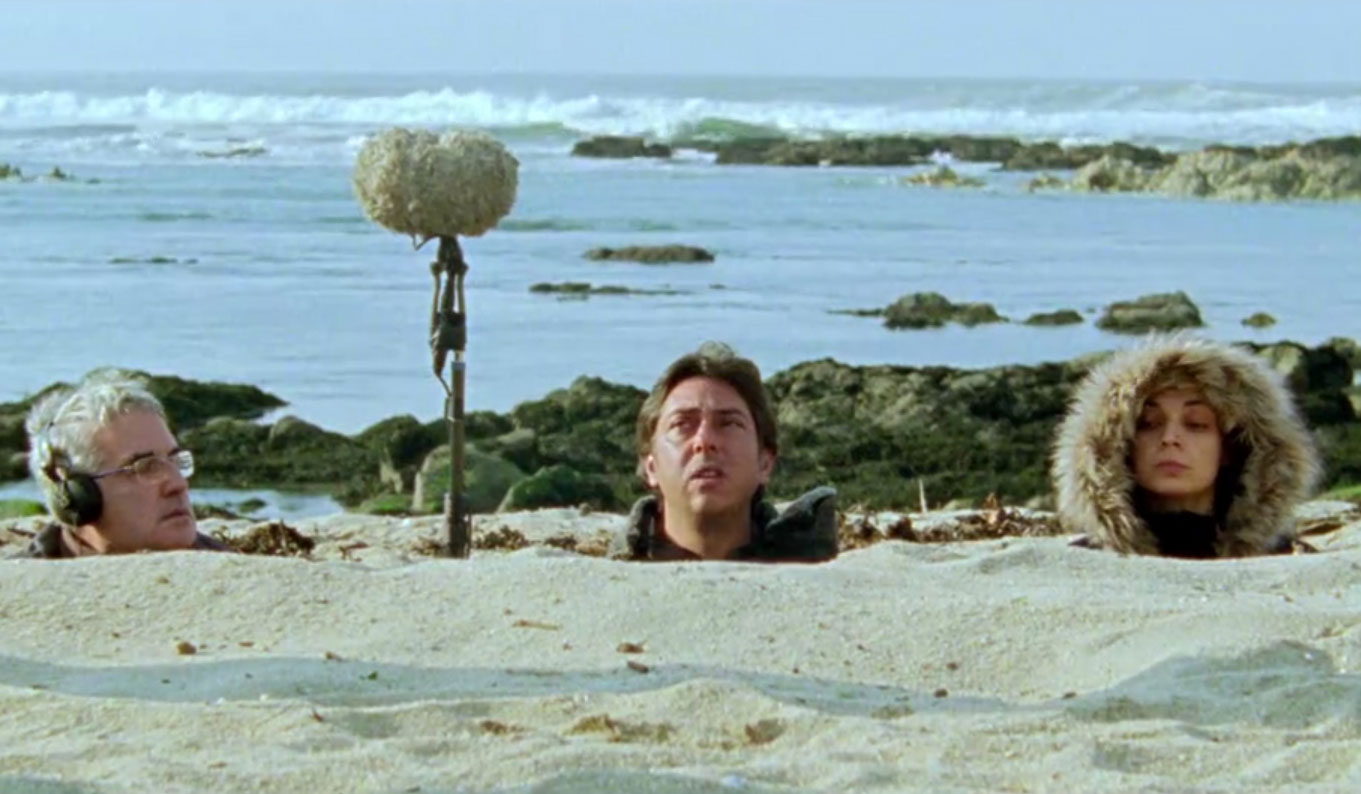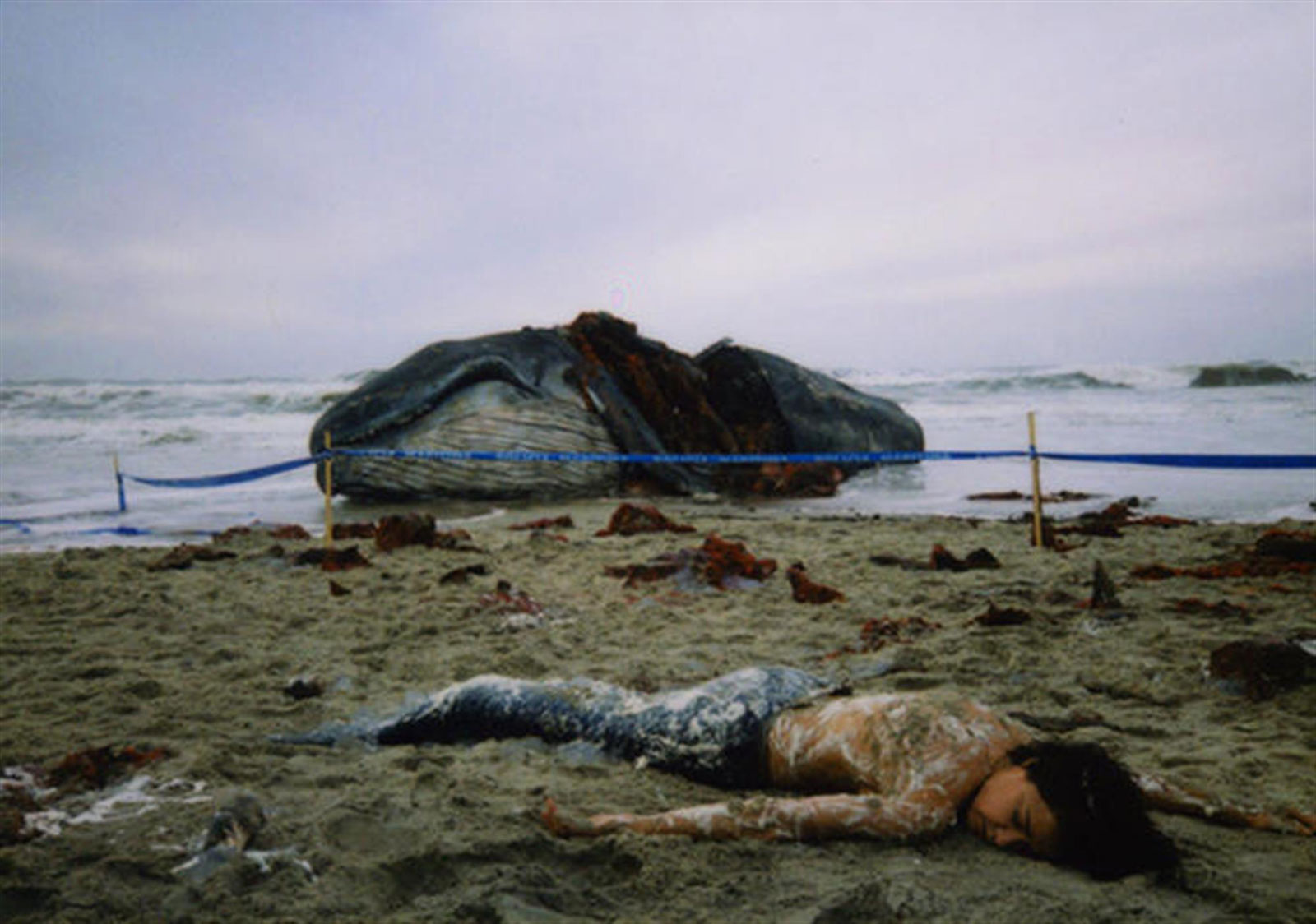Miguel Gomes’s majestic new movie Arabian Nights begins not, as the original Nights do, in the time of “the ancient kings of Persia, who extended their empire into the Indies, over all the islands thereunto belonging, a great way beyond the Ganges and as far as China,” but in the soon to be disused shipyards of Viana do Castelo, in the depressed north of modern Portugal. Multicolored cranes, observed from a hand-held camera, loom through a grey mist, while voices on the soundtrack recall with nostalgia the years when the shipyards were busy with two thousand workers—before the melancholy of European austerity. There are no sherbets, no hunting parties, no silks: this movie employs a different vocabulary of cigarettes, drizzle, plastic signs, and metal fences.
As a superimposed text will soon remind the dazed viewer:
This film is not an adaptation of the book Arabian Nights despite drawing on its structure. The stories, characters and places that Scheherazade will tell us about acquired a fictional form from facts that occurred in Portugal between August 2013 and July 2014. During this period the country was held hostage to a programme of economic austerity executed by a government apparently devoid of social justice.
And then the manic cascade of stories begins—a cockerel put on trial for crowing too early, crazed government ministers, an exploding whale…
The original Arabian Nights, an apparently self-generating fable of life, death, and storytelling, unfolds in a ramshackle structure, a nested organization of stories within stories—and Gomes’s film has an emulatively giant length. The movie lasts more than six hours, and is divided into three parts—“The Restless One,” “The Desolate One,” and “The Enchanted One”—each of which is in turn divided into three or four named stories, which vary in length but which each last roughly thirty to forty-five minutes. It’s a long film that is also a series of shorts. To make the movie, Gomes set up a troupe: a mini office of investigative journalists, whose job was to come to him with raw material from Portugal’s recession; and a cinematographer, Sayombhu Mukdeeprom, who had worked with the extravagant Thai director Apichatpong Weerasethakul (another combination, therefore, of the everyday and the visionary).
The first story in Gomes’s film, “The Work of the Film Director, of the Shipyard Worker, and of the Wasp Exterminator,” begins in those shipyards in Viana, then shifts to a wasp exterminator. But meanwhile Gomes himself appears, dejectedly sitting at the edge of a shoot. “My job is to direct films,” he observes, in voiceover. But what kind of job is it, to direct films, and what kind of object does a filmmaker make? Why, in other words, is he here, filming shipyard workers about to be laid off?
I’m in Viana because it seems impossible to me to make a film, today, in Portugal, and leave them out… I’m also in Viana because Mr Vítor is fighting, on his own, a plague of Asian hornets which threatens to decimate the bees and destroy local honey production… Apart from these two things occurring simultaneously in the same place, I see no other connection between these events. I believe there might be a link of a metaphorical type, between the workers’ lay-off and the eradication of the plague of wasps. But I can’t explain what that is because I’m stupid and abstraction gives me vertigo.
Then Gomes furtively stands up, and runs out of the shot. And, while the crew runs after him, his voiceover continues its despairing ruminations:
Our current situation stems from what I consider today the dumbest idea of my life. I thought I could make a fine film, filled with wonderful and seductive stories. At the same time, I thought the film could follow, for one year, Portugal’s current miserable situation. Any muttonhead understands that, more or less skillfully, one of these two films can be made. But it’s impossible to make both at once.
The dream is of pure lightness (a film as fantasia) and simultaneously of pure weight (a film as witness). Or, to put this another way: How do you take political and aesthetic risks in a film’s form while dramatizing them within that film as well? It’s a question containing such intricate contradictions that it leaves him, “the helpless paralyzed director,” in flight from his own movie. The despairing solution he offers is to displace the storytelling one more time: to disappear, and to insert an extra layer to the fiction, allowing the stories to be told by a new version of Scheherazade, in a new version of the Arabian Nights.
Advertisement
The Arabian Nights, of course—written and rewritten between the tenth and fourteenth centuries, and translated into French by Antoine Galland at the beginning of the eighteenth century—have nourished many subsequent fictions, from Ahmad Faris al-Shidyaq to James Joyce. A reader only needs to remember the celebrated names: Aladdin! Sinbad the Sailor! Or the tale that forms its outermost layer, where the Grand Vizier’s daughter Scheherazade tells a story every morning before dawn, to avert her execution by Schahriar, the Sultan driven murderously misogynist on discovering his wife’s infidelity.
You can derive a sequence of theorems from the original Nights: that storytelling is a matter of life and death, since an execution can be postponed by a story; that a story can be infinitely extended, because any character is capable of beginning a new supernatural tale; and that what might seem a story about the supernatural may also, or in fact, be a story about power. (Money, in the Nights, is always woozy with transformative potential, all sudden multiplications and terrible subtractions.)
Viewed through the haze of Gomes’s film, the book emerges as a sumptuous, hyper version of the filmmaker’s previous works—above all, in the way that it offers lessons in stories that require the presence of another story: a work as an anthology. Gomes has always enjoyed combining two separate elements in a single film, and in Arabian Nights this technique is cosmically expanded. Each new story stylistically corrects or contradicts the story preceding it. (Other movies can seem so uniform, after a period of Gomes-viewing…) An index of the film’s second part, “The Desolate One,” is an exercise in genre revision: a slow western about an escaped convict on the run from police is followed by a theatrical and nocturnal court proceeding, in some kind of amphitheater, complete with genie and talking cow, which is then followed by a vérité story set in a rundown tower block.
Miguel Gomes was born in Portugal in 1972. His early career followed the old-fashioned nouvelle vague model: an education in film criticism, and an apprenticeship in short films. He made his first feature in 2004, when he was thirty-two, The Face You Deserve—a film that somehow manages to morph from a story about a mid-life crisis into a remake of Snow White and the Seven Dwarfs. He followed that in 2008 with Our Beloved Month of August, and then, in 2012, with Tabu, a meticulous diptych of a pristinely contemporary Lisbon and its colonial African past. They are a record of high-speed artistic restlessness, where any style is possible—everyday social realismo and fantastical fable, 16mm haze and 35mm precision, historical investigation and genre pastiche—grounded, I think, by the freedom with which Gomes happily displays the frame, gently foregrounding a story’s narrator, or the making of the film itself. It’s a form of cinematic thinking that leads to his seductive innovation: Gomes tends to prefer a double structure, where a film begins in one mode, and is then completed in another. (One analogue might be what Roberto Bolaño did to novel-construction in The Savage Detectives and 2666). He classified more than one of his early shorts as a film musical, and that musical sense of composition is intrinsic to his art.
In all Gomes’s films, there’s a roving interest in examining how power can be an atmosphere, at once very distant and very intimate—like the way, in Tabu, Portugal’s colonial past was both a distant miasma and also the precondition for the characters’ wildest, most passionate moments. And that investigation is at its most intense in Arabian Nights. In an interview with Libération, Gomes told a small anecdote about one origin of the work: when his daughter, aged five, asked him to buy something for her, which he refused. Ah, it’s because of the crisis, she sagely replied. “I think she didn’t really know what that meant,” he added, “except that it was something which made people spend less money. And I think I remembered that moment when I began this project.” It’s such a miniature origin for such a giant work—but then that play with ordinary proportion is also one of the film’s defining methods, a way of examining a particular problem. Wherever you go in Europe, you can hear this word crisis—but what does crisis actually mean? The term refers to a pure political abstraction which is also a constricting, reticulated influence on the most everyday actions—as minute as not buying a toy for one’s daughter, or not being able to look after a stray animal.
Advertisement
The story “The Owners of Dixie,” which concludes “The Desolate One,” is split into three parts. It recounts the adventures of Dixie, “a gracious and intelligent dog,” and its first part describes his first owners: a woman called Glória, then a middle-aged and ill couple, Luísa and Humberto. Then follows an interlude, in which Luísa and Humberto tell mini tales about the tower block where they live to a young couple they meet, Vasco and Vania, a former dealer and a recovering addict. Vasco and Vania become Dixie’s new owners—but are too poor to keep him. And so they give Dixie to the block’s super, Ana, who looks after him with her grandchildren. The story is tenderly attentive to the everyday, gathering up prodigious detail in its loping drift (a dusty game of cricket played by immigrant Indian children, or a black cloud of barbecue smoke from a balcony, like an escaping genie), but this detail multiplies into a dual and moving narrative: at once a story about the variously loving relationships inspired by the dog, and the absence of money which makes these relationships impermanent.
One way of talking about power in fiction is to talk about the marvelous, and while the original Nights represents one of literature’s most exuberant explorations of what the marvelous might mean, it’s a category that perhaps cinema can most fluently investigate—with the absolute materialist authority a film confers on visionary events (like the way in Carl Theodor Dreyer’s Ordet (1955) Inger Borgen seems, very quietly, to rise from the dead). Gomes has his own deadpan way with the supernatural—in his lo-fi filming of Scheherazade in an imaginary seaside Baghdad, or his presentation of a “wind genie” as a man accidentally trapped in a bird-net. But the true meaning of the marvelous, Gomes seems to be suggesting, is in the way a life is constantly being changed by powers beyond its control or prediction—a system of everyday metamorphosis which is at its most intense in an era of austerity poverty. Not, however, that it must always therefore be a record of defeat. There’s a hopeful version of the marvelous too, and it’s visible in the final story, “The Inebriating Chorus of the Chaffinches”—a study of bird-trappers in Lisbon’s outer suburbs, living in government housing on the sites of former shanty towns out by the airport. It’s very small, almost nothing, but in the miniature actions of cage-cleaning and bird-training, or the way the trappers invent impossible birdsongs on their computers by combining different melodies into a single artificial track, some kind of small-scale, improvised utopia emerges.
The way Gomes concludes his extravaganza is with a final unexpected novelty, a children’s choir singing a version of the Carpenters’ “Calling Occupants of Interplanetary Craft.” It’s a conclusion of a sort, I guess, a grand finale to the film’s motifs of cosmic storytelling, but it’s also simply another new element in the marvelous montage, as if montage could continue forever, according to the terms of Gomes’s liberated art—just as the original Nights end on the Sultan’s realization that Scheherazade would “never be at a loss for these sort of stories to divert me.” And so he lets her live.





